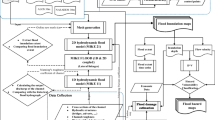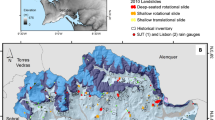Abstract
This paper proposes a multidimensional landslide warning method based on statistical and physical models. Firstly, the least square linear fitting (LSF), quantile regression (QR), and logistic regression (LR) methods are used to establish the cumulative rainfall-duration-mean intensity (E-D-I) threshold models based on the rainfall landslide events in Sangzhi County, Hunan Province, from 1987 to 2007, which improve the threshold precision compared with traditional I-D analysis. Then, the thresholds are quantitatively compared using list skill scores and receiver operating characteristic (ROC) curves. The results show that the skill score of TLR for E-D performed the best, indicating that the corresponding threshold equation is the most suitable for Sangzhi County. Further, the improved SINMAP model is used to analyze the slope stability for Liyuan, Sangzhi County, under four rainfall return periods of 5, 10, 20, and 50 years. By the relationship between rainfall and landslide instability probability, the rainfall threshold inducing the landslide in Liyuan Town is determined to be 120 mm/day. Finally, the landslide events from 2008 to 2017 in the SINMAP model are extracted to verify the appropriateness of the threshold equation. At least 75% (in fact, 100% of TLR for E-D) of the landslide events are above all thresholds of 0.5 percentile. The converted I-D thresholds share similar trends compared with similar working areas globally. The multidimensional threshold proposed can provide a theoretical basis for preventing and managing landslide disasters in Sangzhi County, which is of significant academic value and has practical implications.











Similar content being viewed by others
References
Abbate A, Papini M, Longoni L (2021) Analysis of meteorological parameters triggering rainfall-induced landslide: a review of 70 years in Valtellina. Nat Hazards Earth Syst Sci 21(7):2041–2058
Adams BJ, Fraser HG, Howard CD, Sami Hanafy M (1986) Meteorological data analysis for drainage system design. J Environ Eng 112(5):827–848
Baum RL, Godt JW (2010) Early warning of rainfall-induced shallow landslides and debris flows in the USA. Landslides 7:259–272
Beven KJ, Kirkby MJ (1979) A physically based, variable contributing area model of basin hydrology. Hydrol Sci J 24(1):43–69
Birgit T, Roger K (2009) Slope stability modeling with SINMAP in a settlement area of the Swabian Alb. Landslides 6(4):309–319
Bordoni M, Corradini B, Lucchelli L, Valentino R, Bittelli M, Vivaldi V, Meisina C (2019) Empirical and physically based thresholds for the occurrence of shallow landslides in a prone area of northern Italian Apennines. Water 11(12):2653
Bueechi E, Klimeš J, Frey H, Huggel C, Strozzi T, Cochachin A (2019) Regional-scale landslide susceptibility modeling in the Cordillera Blanca. Peru of Different Approaches Landslides 16(2):395–407
Caine (1980) The rainfall intensity-duration control of shallow landslides and debris flows. Geografiska Annaler Series A 62(1/2):23–27
Cambell (1975) Debris floes originate from soil slips during rainstorms in southern California. Eng Geol 7:339–349
Chen CY, Chen TC, Yu FC, Lin SC (2005) Analysis of time-varying rainfall infiltration induced landslide. Environ Geol 48(4–5):466–479
Conrad JL, Morphew MD, Baum RL, Mirus BB (2021) HydroMet: a new code for automated objective optimization of hydrometeorological thresholds for landslide initiation. Water 13(13):1752
Dahal RK, Hasegawa S (2008) Representative rainfall thresholds for landslides in the Nepal Himalaya. Geomorphology 105:374–374
Domènech G, Alvioli M, Corominas J (2020) Preparing first-time slope failures hazard maps: from pixel-based to slope unit-based. Landslides 17:249–265
Froude MJ, Petley DN (2018) Global fatal landslide occurrence from 2004 to 2016. Nat Hazards Earth Syst Sci 18(8):2161–2181
Galanti Y, Barsanti M, Cevasco A, D’Amato Avanzi G, Giannecchini R (2017) Comparison of statistical methods and multi-time validation for the determination of the shallow landslide rainfall thresholds. Landslides 15(5):937–952
Gariano SL, Brunetti MT, Iovine G, Melillo M, Peruccacci S, Terranova O, Vennari C, Guzzetti F (2015) Calibration and validation of rainfall thresholds for shallow landslide forecasting in Sicily, southern Italy. Geomorphology 228:653–665
Guzzetti F, Peruccacci S, Rossi M, Stark C (2007) Rainfall thresholds for the initiation of landslides in central and southern Europe. Meteorol Atmos Phys 98(3–4):239–267
Hanssen AW, Kuipers WJA (1965) On the relationship between the frequency of rain and various meteorological parameters. Koninklijk Nederlands Meteorologisch Institut, Meded. Verhand
Harilal GT, Madhu D, Ramesh MV, Pullarkatt D (2019) Towards establishing rainfall thresholds for a real-time landslide early warning system in Sikkim. India Landslides 16(12):2395–2408
He J, Qiu H, Qu F, Hu S, Yang D, Shen Y, Zhang Y, Sun H, Cao M (2021) Prediction of spatiotemporal stability and rainfall threshold of shallow landslides using the TRIGRS and Scoops3D models. CATENA 197:104999
Hong M, Kim J, Jeong S (2018) Rainfall intensity-duration thresholds for landslide prediction in South Korea by considering the effects of antecedent rainfall. Landslides 15(3):523–534
Hong Y, Adler RF (2008) Predicting global landslide spatiotemporal distribution: Integrating landslide susceptibility zoning techniques and real-time satellite rainfall estimates. Int J Sediment Res 23(3):249–257
Keles F, Nefeslioglu HA (2021) Infinite slope stability model and steady-state hydrology-based shallow landslide susceptibility evaluations: the Guneysu catchment area (Rize, Turkey). CATENA 200:105161
Kim SW, Chun KW, Kim M, Catani F, Choi B, Seo JI (2021) Effect of antecedent rainfall conditions and their variations on shallow landslide-triggering rainfall thresholds in South Korea. Landslides 18:569–582
Lee JH, Kim H, Park HJ, Heo JH (2021a) Temporal prediction modeling for rainfall-induced shallow landslide hazards using extreme value distribution. Landslides 18:321–338
Lee WY, Park SK, Sung HH (2021b) The optimal rainfall thresholds and probabilistic rainfall conditions for a landslide early warning system for Chuncheon, Republic of Korea. Landslides 18:1721–1739
Mandal P, Sarkar S (2021) Estimation of rainfall threshold for the early warning of shallow landslides along National Highway-10 in Darjeeling Himalayas. Nat Hazards 105(3):2455–2480
Marin RJ, Garcíab EF, Aristizábal E (2020) Effect of basin morphometric parameters on physically-based rainfall thresholds for shallow landslides. Eng Geol 278:105855
Michel GP, Kobiyama M, Goerl RF (2014) Comparative analysis of SHALSTAB and SINMAP for landslide susceptibility mapping in the Cunha River basin, southern Brazil. J Soils Sediments 14:1266–1277
Miller S, Brewer T, Harris N (2009) Rainfall thresholding and susceptibility assessment of rainfall-induced landslides: application to landslide management in St Thomas. Jamaica Bull Eng Geol Environ 68(4):539–550
Montgomery DR, Dietrich WE (1994) A physically-based model for the topographic control on shallow landsliding. Water Resour Res 30(4):1153–1171
Nery TD, Vieira BC (2015) Susceptibility to shallow landslides in a drainage basin in the Serra do Mar, São Paulo, Brazil, predicted using the SINMAP mathematical model. Bull Eng Geol Environ 74:369–378
Pack RT, Tarbotyon DG, Goodwin CN (2005) A stability index approach to terrain stability hazard mapping SINMAP user’s manual. Canadian Forest Products Ltd
Peres DJ, Cancelliere A (2021) Comparing methods for determining landslide early warning thresholds: potential use of non-triggering rainfall for locations with scarce landslide data availability. Landslides 18:3135–3147
Peruccacci S, Brunetti MT, Luciani S, Vennari C, Guzzetti F (2012) Lithological and seasonal control on rainfall thresholds for the possible initiation of landslides in central Italy. Geomorphology 139–140:79–90
Petley D (2012) Global patterns of loss of life from landslides. Geology 40:927–930
Ristya Y, Supriatna and Sobirin, (2019) Spatial pattern of landslide potensial area by SMORPH, INDEX STORIE and SINMAP method In Pelabuhanratu and surrounding area, Indonesia. IOP Conf Ser: Earth Environ Sci 338:012033
Witze A (2014) Afghan landslide was 'an accident waiting to happen. Nature 15158
Zhang F, Huang X (2018) Trend and spatiotemporal distribution of fatal landslides triggered by non-seismic effects in China. Landslides 15:1663–1674
Zhang SJ, Xu CX, Wei FQ, Hu KH, Xu H, Zhao LQ, Zhang GP (2019) A physics-based model to derive rainfall intensity-duration threshold for debris flow. Geomorphology 351:106930
Zhao BR, Dai Q, Han DW, Zhang J, Zhuo L, Berti M (2020) Application of hydrological model simulations in landslide predictions. Landslides 17:877–891
Zhuang J, Peng J, Wang G, Iqbal J, Zhu X (2016) Prediction of rainfall-induced shallow landslides in the Loess Plateau, Yan’an, China, using the TRIGRS model. Earth Surf Process Landf 42(6):915–927
Funding
The authors received financial support provided by the National Natural Science Fund Project of China (No. 41772314), the Key Research and Development Project of Hubei Province (No. 2021BCA219), and the Natural Science Foundation of Jiangsu Higher Education Institutions (No. 20KJB170020).
Author information
Authors and Affiliations
Corresponding author
Rights and permissions
Springer Nature or its licensor holds exclusive rights to this article under a publishing agreement with the author(s) or other rightsholder(s); author self-archiving of the accepted manuscript version of this article is solely governed by the terms of such publishing agreement and applicable law.
About this article
Cite this article
Sheng, Y., Li, Y., Xu, G. et al. Threshold assessment of rainfall-induced landslides in Sangzhi County: statistical analysis and physical model. Bull Eng Geol Environ 81, 388 (2022). https://doi.org/10.1007/s10064-022-02890-x
Received:
Accepted:
Published:
DOI: https://doi.org/10.1007/s10064-022-02890-x




